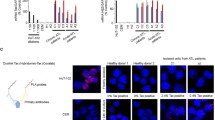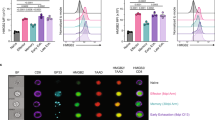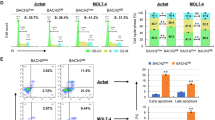Abstract
Human T-cell leukemia virus type 1 (HTLV-1) is an oncogenic retrovirus that induces a fatal T-cell malignancy, adult T-cell leukemia (ATL). Among several regulatory/accessory genes in HTLV-1, HTLV-1 bZIP factor (HBZ) is the only viral gene constitutively expressed in infected cells. Our previous study showed that HBZ functions in two different molecular forms, HBZ protein and HBZ RNA. In this study, we show that HBZ protein targets retinoblastoma protein (Rb), which is a critical tumor suppressor in many types of cancers. HBZ protein interacts with the Rb/E2F-1 complex and activates the transcription of E2F-target genes associated with cell cycle progression and apoptosis. Mouse primary CD4+ T cells transduced with HBZ show accelerated G1/S transition and apoptosis, and importantly, T cells from HBZ transgenic (HBZ-Tg) mice also demonstrate enhanced cell proliferation and apoptosis. To evaluate the functions of HBZ protein alone in vivo, we generated a new transgenic mouse strain that expresses HBZ mRNA altered by silent mutations but encoding intact protein. In these mice, the numbers of effector/memory and Foxp3+ T cells were increased, and genes associated with proliferation and apoptosis were upregulated. This study shows that HBZ protein promotes cell proliferation and apoptosis in primary CD4+ T cells through activation of the Rb/E2F pathway, and that HBZ protein also confers onto CD4+ T-cell immunophenotype similar to those of ATL cells, suggesting that HBZ protein has important roles in dysregulation of CD4+ T cells infected with HTLV-1.
This is a preview of subscription content, access via your institution
Access options
Subscribe to this journal
Receive 50 print issues and online access
$259.00 per year
only $5.18 per issue
Buy this article
- Purchase on Springer Link
- Instant access to full article PDF
Prices may be subject to local taxes which are calculated during checkout






Similar content being viewed by others
References
Matsuoka M, Jeang KT . Human T-cell leukaemia virus type 1 (HTLV-1) infectivity and cellular transformation. Nat Rev Cancer 2007; 7: 270–280.
Matsuoka M, Yasunaga JI . Human T-cell leukemia virus type 1: replication, proliferation and propagation by Tax and HTLV-1 bZIP factor. Curr Opin Virol 2013; 3: 684–691.
Gillet NA, Malani N, Melamed A, Gormley N, Carter R, Bentley D et al. The host genomic environment of the provirus determines the abundance of HTLV-1-infected T-cell clones. Blood 2011; 117: 3113–3122.
Melamed A, Laydon DJ, Gillet NA, Tanaka Y, Taylor GP, Bangham CR . Genome-wide determinants of proviral targeting, clonal abundance and expression in natural HTLV-1 infection. PLoS Pathog 2013; 9: e1003271.
Philip S, Zahoor MA, Zhi H, Ho YK, Giam CZ . Regulation of human T-lymphotropic virus type I latency and reactivation by HBZ and Rex. PLoS Pathog 2014; 10: e1004040.
Yasunaga J, Matsuoka M . Molecular mechanisms of HTLV-1 infection and pathogenesis. Int J Hematol 2011; 94: 435–442.
Gaudray G, Gachon F, Basbous J, Biard-Piechaczyk M, Devaux C, Mesnard JM . The complementary strand of the human T-cell leukemia virus type 1 RNA genome encodes a bZIP transcription factor that down-regulates viral transcription. J Virol 2002; 76: 12813–12822.
Satou Y, Yasunaga J, Yoshida M, Matsuoka M . HTLV-I basic leucine zipper factor gene mRNA supports proliferation of adult T cell leukemia cells. Proc Natl Acad Sci USA 2006; 103: 720–725.
Fan J, Ma G, Nosaka K, Tanabe J, Satou Y, Koito A et al. APOBEC3G generates nonsense mutations in human T-cell leukemia virus type 1 proviral genomes in vivo. J Virol 2010; 84: 7278–7287.
Mitobe Y, Yasunaga J, Furuta R, Matsuoka M . HTLV-1 bZIP Factor RNA and Protein Impart Distinct Functions on T-cell Proliferation and Survival. Cancer Res 2015; 75: 4143–4152.
Satou Y, Matsuoka M . Molecular and cellular mechanism of leukemogenesis of ATL: emergent evidence of a significant role for HBZ in HTLV-1-induced pathogenesis. Leuk Res Treat 2012; 2012: 213653.
Classon M, Harlow E . The retinoblastoma tumour suppressor in development and cancer. Nat Rev Cancer 2002; 2: 910–917.
Dyson N . The regulation of E2F by pRB-family proteins. Genes Dev 1998; 12: 2245–2262.
Satou Y, Yasunaga J, Zhao T, Yoshida M, Miyazato P, Takai K et al. HTLV-1 bZIP factor induces T-cell lymphoma and systemic inflammation in vivo. PLoS Pathog 2011; 7: e1001274.
Dick FA, Rubin SM . Molecular mechanisms underlying RB protein function. Nat Rev Mol Cell Biol 2013; 14: 297–306.
Kehn K, Fuente Cde L, Strouss K, Berro R, Jiang H, Brady J et al. The HTLV-I Tax oncoprotein targets the retinoblastoma protein for proteasomal degradation. Oncogene 2005; 24: 525–540.
Trimarchi JM, Lees JA . Sibling rivalry in the E2F family. Nat Rev Mol Cell Biol 2002; 3: 11–20.
Polager S, Ginsberg D . p53 and E2f: partners in life and death. Nat Rev Cancer 2009; 9: 738–748.
Komarov PG, Komarova EA, Kondratov RV, Christov-Tselkov K, Coon JS, Chernov MV et al. A chemical inhibitor of p53 that protects mice from the side effects of cancer therapy. Science 1999; 285: 1733–1737.
Davidson W, Ren Q, Kari G, Kashi O, Dicker AP, Rodeck U . Inhibition of p73 function by Pifithrin-alpha as revealed by studies in zebrafish embryos. Cell Cycle 2008; 7: 1224–1230.
Boyer SN, Wazer DE, Band V . E7 protein of human papilloma virus-16 induces degradation of retinoblastoma protein through the ubiquitin-proteasome pathway. Cancer Res 1996; 56: 4620–4624.
Munakata T, Liang Y, Kim S, McGivern DR, Huibregtse J, Nomoto A et al. Hepatitis C virus induces E6AP-dependent degradation of the retinoblastoma protein. PLoS Pathog 2007; 3: 1335–1347.
Knight JS, Sharma N, Robertson ES . Epstein-Barr virus latent antigen 3C can mediate the degradation of the retinoblastoma protein through an SCF cellular ubiquitin ligase. Proc Natl Acad Sci USA 2005; 102: 18562–18566.
Borchert S, Czech-Sioli M, Neumann F, Schmidt C, Wimmer P, Dobner T et al. High-affinity Rb binding, p53 inhibition, subcellular localization, and transformation by wild-type or tumor-derived shortened Merkel cell polyomavirus large T antigens. J Virol 2014; 88: 3144–3160.
Swaims AY, Khani F, Zhang Y, Roberts AI, Devadas S, Shi Y et al. Immune activation induces immortalization of HTLV-1 LTR-Tax transgenic CD4+ T cells. Blood 2010; 116: 2994–3003.
Arpin-Andre C, Laverdure S, Barbeau B, Gross A, Mesnard JM . Construction of a reporter vector for analysis of bidirectional transcriptional activity of retrovirus LTR. Plasmid 2014; 74: 45–51.
Yoshida M, Satou Y, Yasunaga J, Fujisawa J, Matsuoka M . Transcriptional control of spliced and unspliced human T-cell leukemia virus type 1 bZIP factor (HBZ) gene. J Virol 2008; 82: 9359–9368.
Wu X, Levine AJ . p53 and E2F-1 cooperate to mediate apoptosis. Proc Natl Acad Sci USA 1994; 91: 3602–3606.
Irwin M, Marin MC, Phillips AC, Seelan RS, Smith DI, Liu W et al. Role for the p53 homologue p73 in E2F-1-induced apoptosis. Nature 2000; 407: 645–648.
Bosco EE, Mayhew CN, Hennigan RF, Sage J, Jacks T, Knudsen ES . RB signaling prevents replication-dependent DNA double-strand breaks following genotoxic insult. Nucleic Acids Res 2004; 32: 25–34.
Lowe SW, Cepero E, Evan G . Intrinsic tumour suppression. Nature 2004; 432: 307–315.
Vernin C, Thenoz M, Pinatel C, Gessain A, Gout O, Delfau-Larue MH et al. HTLV-1 bZIP factor HBZ promotes cell proliferation and genetic instability by activating OncomiRs. Cancer Res 2014; 74: 6082–6093.
Zhao T, Satou Y, Sugata K, Miyazato P, Green PL, Imamura T et al. HTLV-1 bZIP factor enhances TGF-beta signaling through p300 coactivator. Blood 2011; 118: 1865–1876.
Yamamoto-Taguchi N, Satou Y, Miyazato P, Ohshima K, Nakagawa M, Katagiri K et al. HTLV-1 bZIP factor induces inflammation through labile Foxp3 expression. PLoS Pathog 2013; 9: e1003630.
Takeda S, Maeda M, Morikawa S, Taniguchi Y, Yasunaga J, Nosaka K et al. Genetic and epigenetic inactivation of tax gene in adult T-cell leukemia cells. Int J Cancer 2004; 109: 559–567.
Katoh T, Harada T, Morikawa S, Wakutani T . IL-2- and IL-2-R- independent proliferation of T-cell lines from adult T-cell leukemia/lymphoma patients. Int J Cancer 1986; 38: 265–274.
Zhao T, Yasunaga J, Satou Y, Nakao M, Takahashi M, Fujii M et al. Human T-cell leukemia virus type 1 bZIP factor selectively suppresses the classical pathway of NF-kappaB. Blood 2009; 113: 2755–2764.
Peloponese Jr JM, Yasunaga J, Kinjo T, Watashi K, Jeang KT . Peptidylproline cis-trans-isomerase Pin1 interacts with human T-cell leukemia virus type 1 tax and modulates its activation of NF-kappaB. J Virol 2009; 83: 3238–3248.
Sawada S, Gowrishankar K, Kitamura R, Suzuki M, Suzuki G, Tahara S et al. Disturbed CD4+ T cell homeostasis and in vitro HIV-1 susceptibility in transgenic mice expressing T cell line-tropic HIV-1 receptors. J Exp Med 1998; 187: 1439–1449.
Arnold J, Zimmerman B, Li M, Lairmore MD, Green PL . Human T-cell leukemia virus type-1 antisense-encoded gene, Hbz, promotes T-lymphocyte proliferation. Blood 2008; 112: 3788–3797.
Acknowledgements
We thank Linda Kingsbury and Kathleen Hayes-Ozello for editorial comments and proofreading. This study was supported by grants from the Ministry of Education, Science, Sports and Culture of Japan to MM (22114003) and JY (26460554) and a grant from the Takeda Science Foundation (JY) and a grant from the National Institutes of Health (CA100730) to PLG. This study was performed as a research program of the Platform for Dynamic Approaches to Living System from the Ministry of Education, Culture, Sports, Science and Technology, Japan (AK), and also supported in part by the JSPS Core-to-Core Program A, Advanced Research Networks.
Author information
Authors and Affiliations
Corresponding author
Ethics declarations
Competing interests
The authors declare no conflict of interest.
Additional information
Supplementary Information accompanies this paper on the Oncogene website
Supplementary information
Rights and permissions
About this article
Cite this article
Kawatsuki, A., Yasunaga, Ji., Mitobe, Y. et al. HTLV-1 bZIP factor protein targets the Rb/E2F-1 pathway to promote proliferation and apoptosis of primary CD4+ T cells. Oncogene 35, 4509–4517 (2016). https://doi.org/10.1038/onc.2015.510
Received:
Revised:
Accepted:
Published:
Issue Date:
DOI: https://doi.org/10.1038/onc.2015.510
This article is cited by
-
Viral, genetic, and immune factors in the oncogenesis of adult T-cell leukemia/lymphoma
International Journal of Hematology (2023)
-
Human T-lymphotropic virus type 1 (HTLV-1) and cellular immune response in HTLV-1-associated myelopathy/tropical spastic paraparesis
Journal of NeuroVirology (2020)
-
Silencers of HTLV-1 and HTLV-2: the pX-encoded latency-maintenance factors
Retrovirology (2019)



